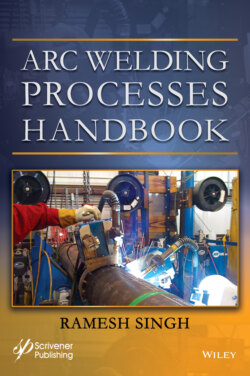Читать книгу Arc Welding Processes Handbook - Ramesh Kumar Singh - Страница 12
Оглавление
List of Tables
Table 1.1 Welding and joining processes, type of energy used, and their abbreviations as defined by the American Welding Society
Table 1.2 Arc efficiency by welding process
Table 1.3 Shows the arc efficiency factors for various commonly used arc welding processes
Table 1.4 Indicates general limits of joining/welding processes that apply to the material listed in left column
Table 1.5 Arc efficiency factor
Table 2.8.3.1 Welding lead and their capacity
Table 2.9.1 Welding lens shades
Table 2.9.2 Helmets with auto adjusting lenses
Table 2.10.1 Electrode classification and A-numbers
Table 2.10.2 Shielded arc welding electrodes
Table 2.11.10 Common SMAW process anomalies and their suggested causes and corrections
Table 2.11.12 Weld defects and suggested changes that can correct them
Table 2.12.1 Aluminum alloy designation system
Table 2.12.5 Cast aluminum designation and numbering system
Table 2.12.6 Temper designation letters and meaning
Table 2.12.23 Stainless steel welding electrodes and heat treatments
Table 2.13 Nominal compositions of some of duplex steels
Table 2.13.1 Nominal mechanical properties of duplex stainless steels
Table 3.10.1 Basic matching guide for electrode size and nozzle
Table 3.11.1 Tungsten electrode tips
Table 3.11.2 Tungsten electrode tips
Table 3.11.3 Types of Tungsten electrode and their identification
Table 3.16.1 Welding cable current carrying capacity
Table 3.17.1 Details the NEMA rating and corresponding current output capacity
Table 3.21.1 Aluminum alloy designation system
Table 3.22.1 Cast aluminum designation and numbering system
Table 3.24.1 Aluminum welding procedures using AC high frequency stabilized arc
Table 3.24.2 GTAW stainless steel welding procedures
Table 3.25.1 Nominal compositions of some of duplex steels
Table 3.25.8 Stainless steel welding wire rod and heat treatments
Table 3.6.2 Nominal mechanical properties of duplex stainless steels
Table 3.29.1 Advantages and limitations of PAW process
Table 4.4.1 Deposition rate of various GMAW metal transfer mode
Table 4.4.1.1 WPS for carbon steel and low alloy steels with short circuit transfer mode
Table 4.4.1.2 Aluminum WPS for short circuit
Table 4.4.1.3 The transition current for spray transfer currents
Table 4.4.1.4.1 Carbon steel – Basic training WPS for spray transfer welding
Table 4.4.1.4.2 Aluminum – Basic training WPS for spray transfer welding
Table 4.5.1 Details the current and the shielding gas type used in spray transfer mode of some of the common materials
Table 4.5.5.1 Gas selection guide
Table 4.12.1.4 Welding lead current carrying capacity
Table 5.5.1 Carbon steel electrodes their use descriptions
Table 5.6.6.1 Impact of shielding gases on the mechanical properties of weld metal
Table 6.10.7 Indicates the basicity of various fluxes
Table 6.11 Common welding electrodes for SAW process
Table 7.1 Pipe schedule
Table 7.2 Terms and abbreviations relating to welding and construction
Table 7.3 F-Number, ASME specification and AWS classification
Table 7.4 P-number, group number, and type of material
Table 7.5 Qualification of metals based on the procedure qualification
Table 7.6 Temperature conversion
Table 7.7 Temperature and pressure
